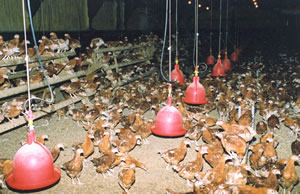
In this month’s Ranger article we are looking at the options available to provide the pullet with good immunity against coccidiosis on the laying site. This is of great importance to the free range flock as, unlike their cage sisters, they are at more risk of exposure to the coccidial parasite on the laying farm.
Why do we worry about coccidia?
Coccidia are protozoal parasites which, when swallowed by the bird invade and multiply in the cells lining the gut wall. There are eight strains of coccidial parasite which can affect laying chickens. When birds are exposed to low levels of coccidia, there is little damage to the intestine and the bird responds to the presence of the coccidia in the intestine by developing resistance.
In an ideal world, birds would be naturally exposed to a low level of coccidia allowing the flock to acquire immunity by ’trickle’ infection without developing any disease problems – a ’balance’ between the bird and the parasite.
However, in reality, even in relatively small flocks, because of the concentration of birds in rearing and laying houses and the persistence of this parasite in the environment, in certain circumstances birds can be exposed to higher levels of parasite and show clinical signs of coccidiosis. This may result in a variety of problems including poor weight gain and unevenness within the flock. If flocks are affected with coccidiosis in lay, this can cause mortality, loss of condition and depression of egg production with deterioration in egg quality.
There can also be significant mortality in severe coccidiosis outbreaks in the rearing stage as the younger the bird, the more vulnerable it is to this parasite. Poor control of coccidiosis in the rearing stage can also lead to very uneven flocks at point of lay.
Options for coccidiosis control
Feed medication: The aim with feed medication during rear is to allow limited exposure to the parasite by providing an anti-coccidial drug in the feed. The risk of coccidia reaching levels at which they will damage the intestine is minimised.
Various drugs can be used in the feed during rear to prevent coccidiosis. Lasalocid (Avatec) is one of the more commonly used medications. Feed manufacturers normally use a step down programme, starting with a higher dose of drug in the starter ration, for example to around 6 weeks, then a reduced dose between 7 and 12 weeks. Some farmers may use a triple step down programme starting with a high level for a shorter period in the starter and then two further reductions during the rearing period. Usually the medication is withdrawn from the feed between 2 and 4 weeks before the birds are moved to the laying site.
Advantages of feed medication are:
It is easy to administer and an inexpensive means of control.
This method can provide good protection to the pullet on the rearing site but also, as it allows trickle exposure, the pullet can develop its own good immunity to protect the bird on the laying site.
The disadvantages of feed medication are:
Birds may not necessarily be exposed to all the strains of coccidia they may meet on the laying site. This is more of a problem now as biosecurity on rearing sites is high.
Method depends on birds eating well. Any other disease or feed quality problem which reduces feed intake will prevent the right intake of anti-coccidial.
For organic pullets, use of a ’drug’ in the feed may be considered not acceptable.
Strategic medication via water during the rearing period: This system relies on strategic treatment with anti-coccidial administered via drinking water. This might be given as a routine treatment at various stages when coccidial challenge is expected to be high or used as an intervention if birds show signs of coccidiosis and require treatment. This approach is probably only suitable for very small groups of birds.
Vaccination: Birds can be vaccinated during the first week of life with a vaccine containing all the strains of coccidia they are likely to meet on the rearing or laying farm but in the form of non pathogenic strains which stimulate development of immunity in the birds without causing significant damage to the intestines.
Vaccine is usually administered via drinking water or, in some cases, by spraying onto feed at day old. It is thought in the future that it may be possible to administer this vaccine by spray at the hatchery.
In certain circumstances, birds have been vaccinated later in life, either prior to or shortly after arrival on the laying site. Although this may be of benefit if heavy challenge is anticipated on the laying flock, the product is not licenced for use in this way. The advantages of vaccination are
If properly administered, birds will have been exposed to all the strains of coccidia they are likely to meet and should be immune to challenge, both on the rearing and the laying site.
The disadvantages are:
Likely to be more expensive than the previous two methods.
Birds must get off to a good start to be capable of responding properly to vaccination.
Administration of vaccine is very critical. If vaccine is not administered properly, birds will not fully respond.
There is a risk if feed containing an anti-coccidial is fed inadvertently to vaccinated flocks, this may reduce the efficacy of the vaccine and birds may not be protected.
Depending on where your pullets are being reared, vaccination may not be an option as if the majority of birds on site are receiving medicated feed to control coccidiosis, it may be impractical for the pullet rearer to use vaccine.
If you have experienced problems with outbreaks of coccidiosis, either on the rearing or laying site, the use of an anti-coccidial disinfectant as part of the terminal cleaning and disinfection programme is recommended to reduce the risk to subsequent flocks.
